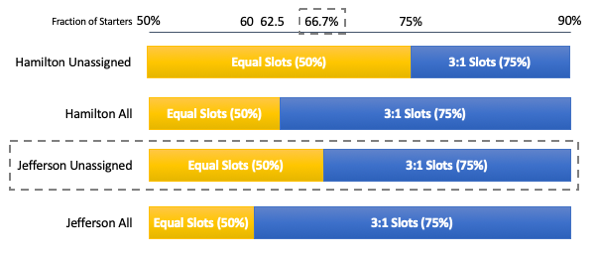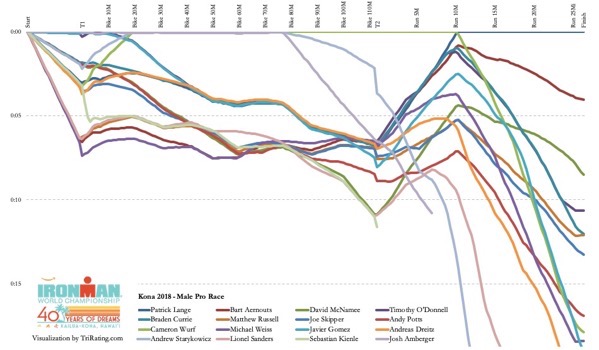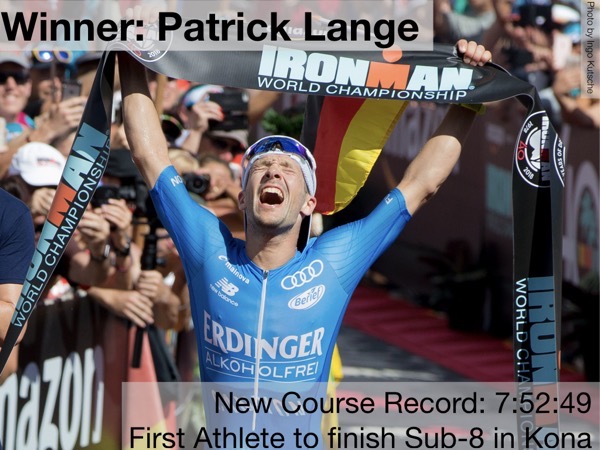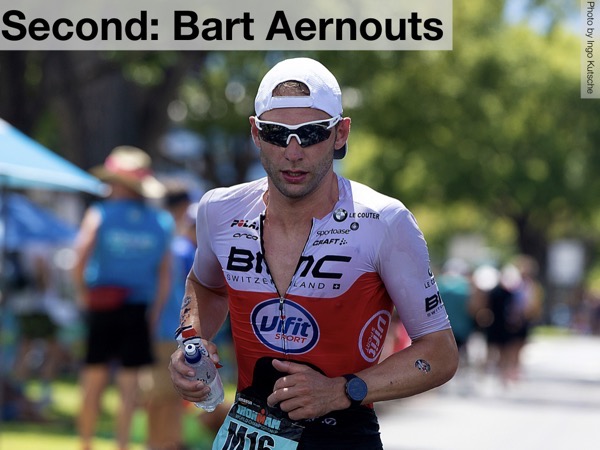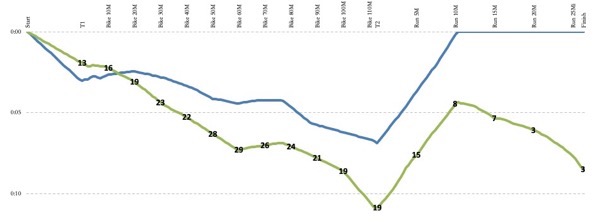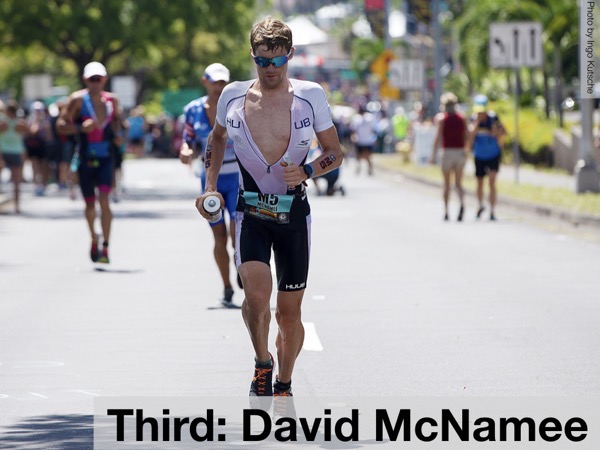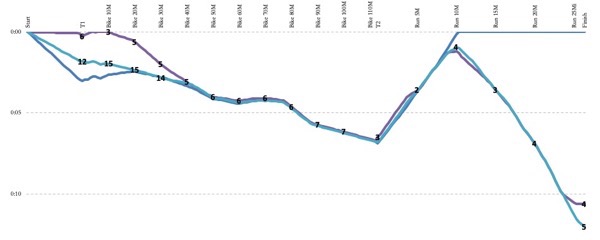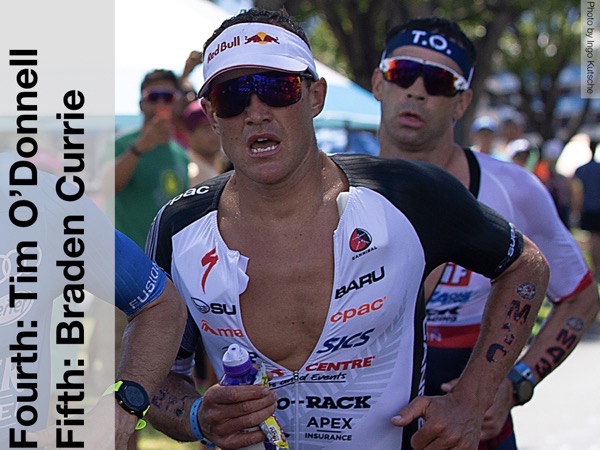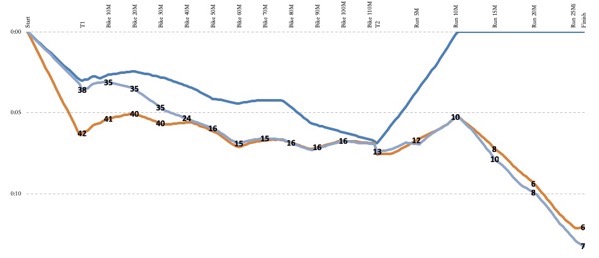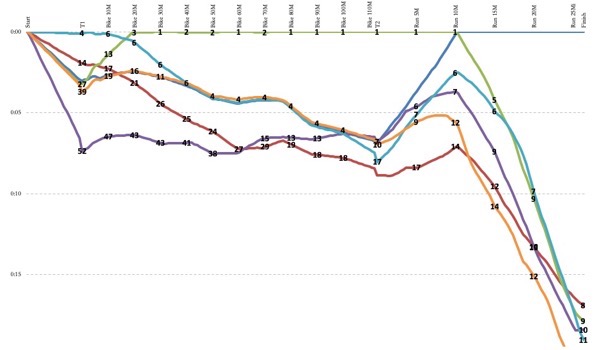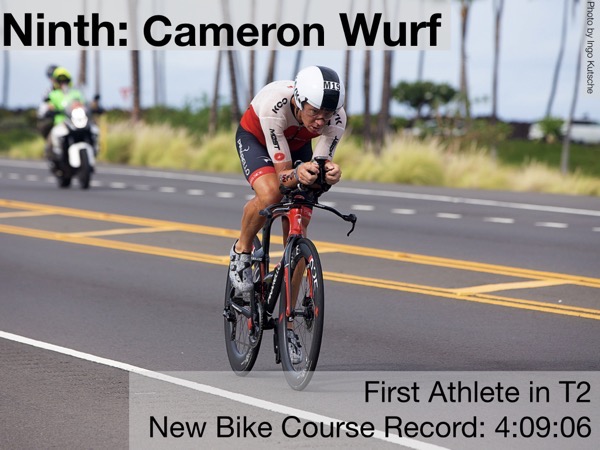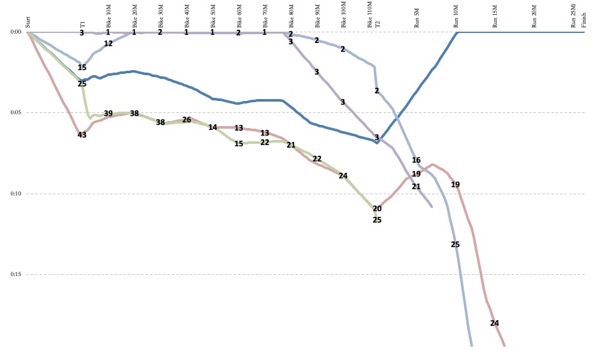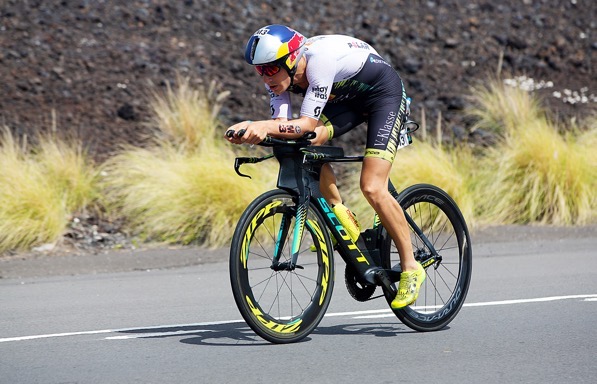Kona 2018 – How the Female Race Unfolded
Here are the results of the top finishers of the female Pro race in Kona 2018 (full results can be found here, a detailed look at the men’s Pro race here):
| Rank | Name | Nation | Swim | Bike | Run | Time | Diff to exp. | Prize Money |
| 1 | Daniela Ryf | SUI | 00:57:27 | 04:26:07 | 02:57:05 | 08:26:18 | -17:26 | US$ 120,000 |
| 2 | Lucy Charles | GBR | 00:48:14 | 04:38:10 | 03:05:50 | 08:36:34 | -25:35 | US$ 60,000 |
| 3 | Anne Haug | GER | 00:54:21 | 04:47:45 | 02:55:20 | 08:41:58 | -30:22 | US$ 40,000 |
| 4 | Sarah True | USA | 00:52:06 | 04:49:19 | 02:57:38 | 08:43:43 | -19:47 | US$ 22,500 |
| 5 | Mirinda Carfrae | AUS | 00:58:18 | 04:46:05 | 03:01:41 | 08:50:45 | -10:54 | US$ 19,000 |
| 6 | Sarah Crowley | AUS | 00:54:19 | 04:43:09 | 03:10:29 | 08:52:30 | -18:51 | US$ 16,000 |
| 7 | Kaisa Sali | FIN | 00:58:23 | 04:44:31 | 03:06:04 | 08:54:28 | -06:45 | US$ 14,000 |
| 8 | Angela Naeth | CAN | 00:58:28 | 04:42:25 | 03:11:11 | 08:57:36 | -35:49 | US$ 12,500 |
| 9 | Corinne Abraham | GBR | 00:58:44 | 04:38:16 | 03:16:26 | 08:57:55 | -12:46 | US$ 11,000 |
| 10 | Linsey Corbin | USA | 00:58:24 | 04:48:29 | 03:07:15 | 08:58:58 | -13:13 | US$ 10,000 |
| 11 | Sarah Piampiano | USA | 01:05:04 | 04:52:01 | 02:59:26 | 09:01:57 | -15:56 | |
| 12 | Liz Blatchford | AUS | 00:52:09 | 04:53:32 | 03:15:17 | 09:06:20 | -05:09 | |
| 13 | Mareen Hufe | GER | 00:58:34 | 04:43:50 | 03:18:40 | 09:06:35 | -11:50 | |
| 14 | Heather Jackson | USA | 00:58:18 | 04:44:45 | 03:21:56 | 09:09:16 | 06:32 |
Here’s the Race Development Graph for these athletes:
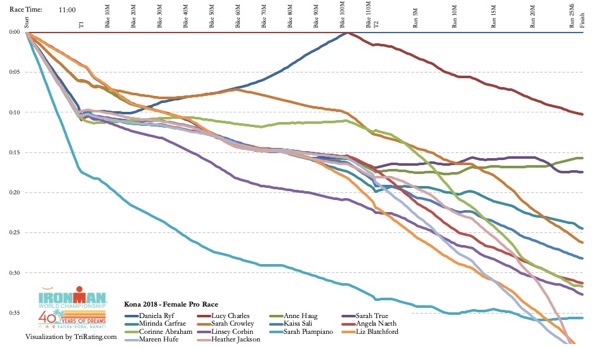
Kona Champion: Daniela Ryf
Even jelly fish stings shortly before the race couldn’t stop Daniela from defending her title and also setting new records:

Before the race there was pretty much agreement that Dani would be able to defend her title unless something serious happened to her. This year, something serious did happened to her – she was stung by jellyfish under both armpits and was seriously thinking about not even starting the race. She decided to give it a try and said she felt so slow that she was sure she was in last place. It wasn’t quite that slow (she still swam under an hour and faster than Mirinda Carfrae or Kaisa Sali), but she lost nine minutes to Lucy Charles (twice as much time as last year) and when she took some extra time in T1 she was even further behind, starting the bike in 22nd place in a group with a few other contenders who were probably very surprised to ride with Dani. She gained a few spots in the first hour of the bike, but didn’t make up any ground to Lucy. But once she passed the Airport, she was able to put the pain from the stings aside and slowly started to move ahead and close the gap. By the turn in Hawi, she had moved into second place and was also riding too fast for Sarah Crowley who had been riding with her for a few miles – but she was still seven minutes behind Lucy.
What followed was a demonstration of her domination on the Ironman distance: She closed the gap to Lucy in the next 40 miles and posted one of the fastest second half bike splits overall. (One of the stats making the round after the race was that she rode the last 70k of the bike quicker than male winner Patrick Lange, and there were only seven Pro men riding that section faster than her.) She took the lead from Lucy at about mile 102 (even a bit earlier than last year) and with a bike split of 4:26:07 annihilated the long-standing bike record (4:44:19 by Karin Thürig from 2011). Even though the conditions were fast this year and there were five more athletes breaking the old record, she still posted the fastest bike split by more than twelve minutes!
Still, Dani started the run only 90 seconds ahead of Lucy, so she still needed a solid run after that very hard bike leg to secure her fourth Kona title in a row. She never allowed any doubt about her marathon (or any hope for Lucy): In fact she almost posted a new marathon PR, her 2:57 missed her best run from 2016 by just 14 seconds. In the end, an ecstatic Dani crossed the line with a ten-minute margin to second place, of course with a new course record of 8:26:07 – an improvement on her 2016 time by more than 20 minutes. In all the excitement on race day it went pretty much unnoticed that this is also the fastest time ever in an Ironman-branded race, there are only three quicker finishes in Roth (8:22 by Dani in 2016 and Chrissie Wellington’s 8:18 and 8:19 in 2010 and 2011).
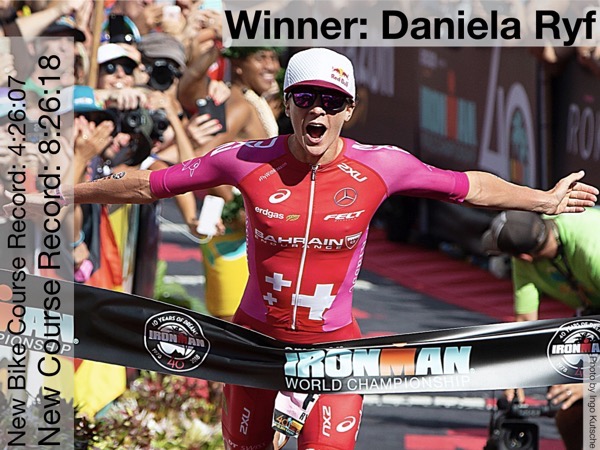
Second: Lucy Charles
With another great performance, Lucy again claimed second place for the second year in a row:

Once again Lucy had a great start of the race and was leading the race into T1. She had said before the race that she wanted to go for the swim course record, and from the gun she was swimming at a hard pace, quickly leaving the rest of the field behind. Her pace was spot on: Her 48:14 broke Jodi Jackson’s 1999 swim course record by 29 seconds. She didn’t know anything of Daniela’s problems during the swim and started to also set a fast pace on the bike. She delivered another great performance in Kona: In addition to breaking the swim course record, she was six minutes faster than the old bike course record, and almost posted a new run PR (she missed her run time from South Africa by five seconds). When she crossed the finish line in 8:36:14, she was ten minutes quicker than the old course record. Nonetheless, Lucy’s 2018 race was pretty much a copy of last year: Leading after the swim and for most of the bike, she was overtaken by Dani shortly before T2, and a good run allowed her to finish second by a good margin to third place: two minutes in 2017, five minutes this year.
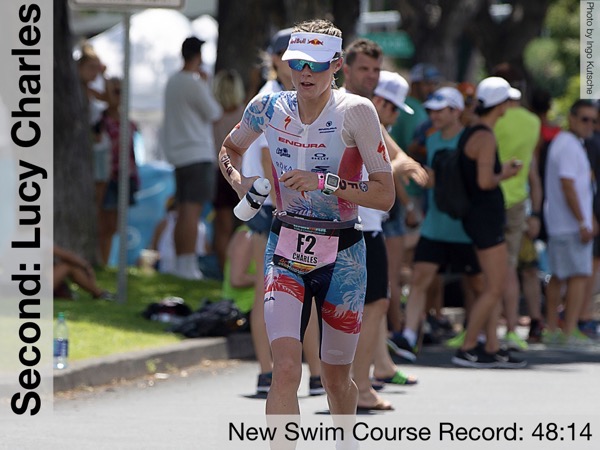
Third and Fourth: Anne Haug & Sarah True
While the first two places were pretty much decided in T2, the race for third was close until just before the finish line when Anne Haug was able to overtake Sarah True:

Both didn’t lose too much time in the swim (four minutes for Sarah, six minutes for Anne), and both were happy to settle into a bigger big group that formed behind the leading athletes. The positions shown in the graph above are a bit misleading – the group was close to 15 athletes riding between fifth and 20th place. For most of the bike ride, the two rookies were happy to follow the pace set by more experienced athletes, eventually riding 15 minutes behind the leaders. Around 90 miles into the bike, Sarah was still feeling good and started to ride a strong, focused pace and the group started to fall apart. Anne was able to match her pace and they started the run in fifth and sixth place within 30 seconds of each other. Sarah and Anne were running the fastest pace in the female field and by the time they left the Energy Lab, they had moved into third and fourth place, still less than a minute apart. Anne was especially strong towards the end, moved into third place less than five miles from the finish and ran the best female marathon of the day with a 2:55 – the fastest Kona run since Rinny’s course run record in 2014.
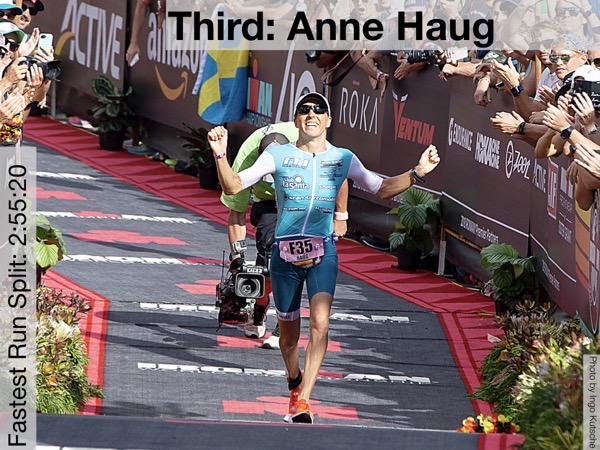
Sarah admits that she ran the first part of the run with too much excitement: “I paid for my early pace after the halfway point and started to have GI distress and problems with nutrition. Before Anne passed me, I was aware that I might have difficulty finishing if I didn’t slow down through aid stations and start to take in more nutrition. While this approach helped me salvage my race, I definitely suffered quite a bit. I don’t remember the last bit of the race which is a shame. I wanted to experience all of Kona, but being in survival mode meant that I don’t remember crossing the finish line very well. I guess I’ll have to go back to experience it fully!”
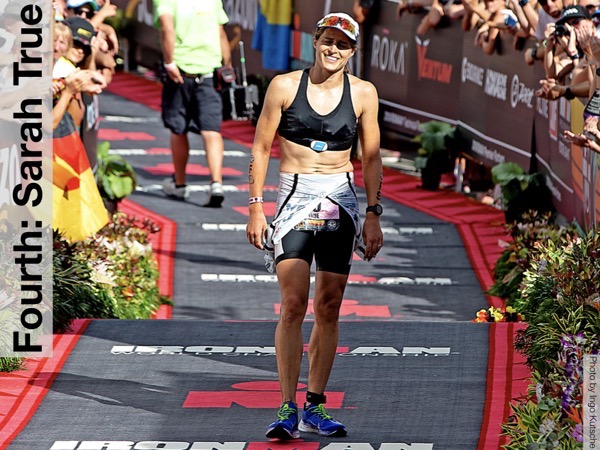
Fifth to Ninth: Mirinda Carfrae, Sarah Crowley, Kaisa Sali, Angela Naeth, and Corinne Abraham
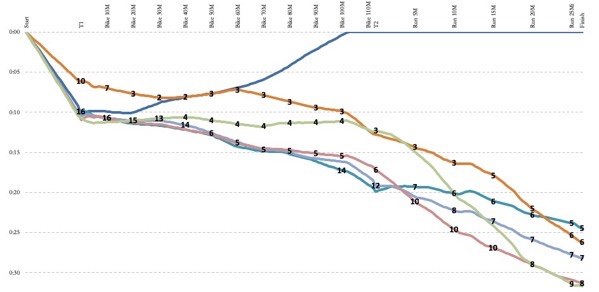
There were two athletes that were able to ride between Lucy and Dani in front and the large bike group about ten to 15 minutes behind the lead. As last year, Sarah Crowley (orange line) was sticking to Daniela, but had to let her go shortly after the turnaround. By T2 she was over twelve minutes back, and she was overtaken by Corinne Abraham (green line) who was able to ride five minutes into the big bike group by posting the third-best bike split (just 6 seconds slower than Lucy Charles). Corinne wasn’t able to do much run training and after the race was happy to finish in ninth place when she rallied to run with Angela Naeth after the Energy Lab. Sarah ran in third place on Ali’i, but then she was overtaken, first by Anne and Sarah and then – shortly after exiting the Energy Lab – by Mirinda Carfrae. Sarah ended up finishing sixth but she was clearly racing for more.
In her comeback season, Mirinda Carfrae (aqua line) had a solid Kona race. She was part of the big bike group that formed after the swim and while she lost almost twenty minutes to Daniela Ryf and started the run in 14th pace, she was just over five minutes behind the podium ranks in T2. Rinny quickly moved into the Top 10, but others from the bike group (Anne Haug, Sarah True) were running a bit quicker than her so this year her run through the field ended in fifth place.
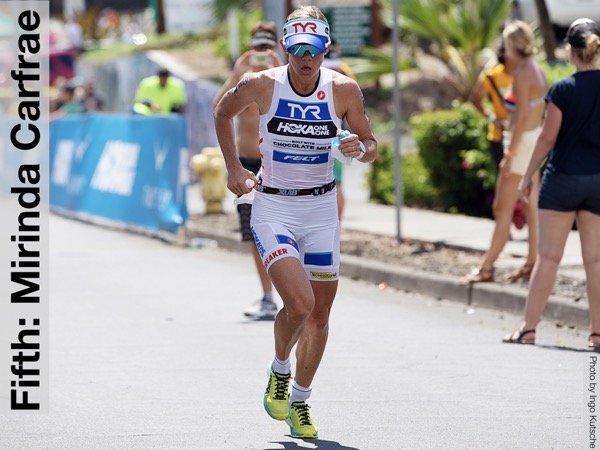
The other proven strong runner in the big bike group was Kaisa Sali (blue line). A 3:06 marathon was good enough for a seventh-place finish but not enough to make up ground to the athletes in front of her. Even though Angela Naeth (red line) was five minutes slower than Kaisa on the run, she is probably quite happy with her Kona marathon – the only time she ever ran a better time was in her win at IM Texas in 2015. Angela has been getting faster in each IM marathon she completed in her 2018 season.
Falling Back and Coming From Behind: Linsey Corbin, Sarah Piampiano, Liz Blatchford, Mareen Hufe and Heather Jackson
There are two different story types for the athletes finishing between ninth and 14th place:
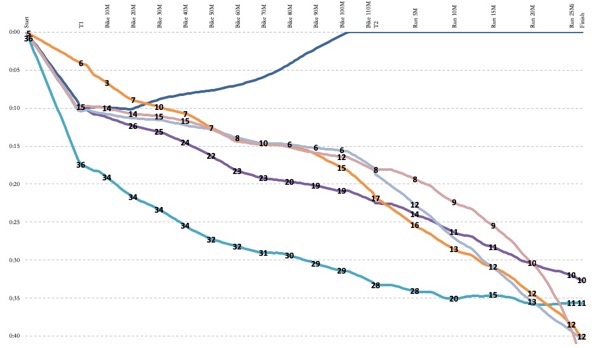
Linsey Corbin (violet line) quickly lost touch with the big bike group, but riding her own pace she didn’t lose too much time: In T2 she was 18th, but only three to five minutes behind a lot of athletes. A steady 3:07 marathon saw her slowly climb the ranks and finish in tenth place, the last Pro to earn prize money.
The fourth sub-3 Kona 2018 marathon was run by Sarah Piampiano (turquoise line) who ended the race in eleventh place. As is typical for her, she lost a lot of time in the swim and started the bike in 36th place (fourth-to-last). By T2 she was able to gain a few spots, but she was still 15 minutes behind tenth place. But she had an almost evenly paced marathon, ending up in eleventh place just three minutes short of the Top 10.
The next three spots were taken by athletes that worked hard on the bike to put themselves in good positions but then didn’t quite have the runs that would have been needed for a Top 10 finish. Liz Blatchford (orange line) lost contact with the bike group in the final miles of the bike but then had a solid 3:15 run to finish twelfth. Mareen Hufe (light blue) was once again one of the strongest athletes on the bike and started the run in the Top 10 but with a lot of strong runners around her. She didn’t concede too many spots, but a 3:18 marathon saw her drop back into 13th place.
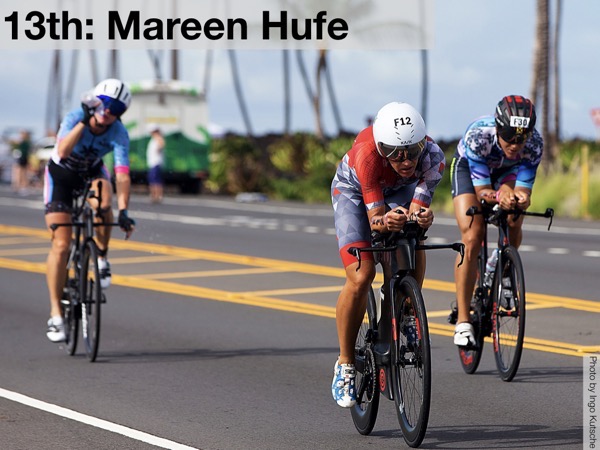
Heather Jackson (pink line) started the run in eighth place and a lot of her fans thought that with her typical fast run she’d be a strong podium contender. But to her own disappointment, she never found a good rhythm and even struggled in the last ten k, dropping back to 14th place.
Credit: All photos by Ingo Kutsche
Observations about the 2018 Female Race
There are a couple of things that have been unusual about the 2018 race:
- Fast Times
Even more than on the men’s side, this year’s Kona was extremely fast. Daniela Ryf set a new course record and also the fastest IM-distance time outside of Roth. There are now 22 sub-9 finishes in Kona – ten of them from this year. Until now, there has never been a year with more than two sub-9 finishes! - Dominance of Daniela
Daniela has now won the last four races in Kona, and all of her wins weren’t even close – the smallest gap was in 2017 when Lucy was nine minutes behind. Even this year’s troubles before the swim didn’t stop Dani. If she continues to stay motivated and (mostly) healthy, there isn’t a real challenger for her in sight. - Big Bike Group
With a big bike group forming after the swim that then gets progressively smaller, the female race is becoming more and more similar to the men’s race. Other than Daniela and Lucy (who were in a separate race for most of the day), no one was rewarded for trying to ride their own pace: Both Sarah Crowley and Corinne Abraham who rode in front of the group fell back on the run, and the best-placed athlete behind the group was Linsey Corbin who finished tenth.
At the same time, the strong bike riders will probably have to think about how they can build a gap in T2 to put some extra pressure on the runners. “Riding steady” as they seemed to do this year is no longer enough to shake off the athletes not quite as strong on the bike, but a gap will be needed if they want to place well in the deep Kona field. - Strong Running required
The marathon in Kona is getting quicker from year to year, and a sub-3:10 run is now almost required for a Top 10 finish. (In 2018 there was only Corinne who was more than a few seconds above 3:10, while there were four each in 2016 and 2017.) While this is also a consequence of the big bike group, this is unlikely to change in the next years – if anything run times will stay at the same level while the bike times are also getting faster. Quite a challenge for the athletes that want to step up to a Top 10 finish!
